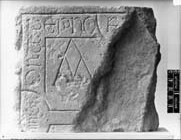Select a site alphabetically from the choices shown in the box below. Alternatively, browse sculptural examples using the Forward/Back buttons.
Chapters for this volume, along with copies of original in-text images, are available here.
Object type: Recumbent grave-marker [1]
Measurements: L. 14.7 cm (5.8 in); W. 17.5 cm (7 in); D. 6 cm (2.4 in)
Stone type: Oolitic limestone [2]
Plate numbers in printed volume: Pl. 17.85-87
Corpus volume reference: Vol 1 p. 51-52
(There may be more views or larger images available for this item. Click on the thumbnail image to view.)
A (broad): The top left-hand corner of an inscribed name-stone. The face is divided into quadrants by an incised cross, type F1, the arms of which reach the outer line of the broad incised border. The inner line of the border stops short before the arms of the cross. The inscription: (a) Within upper left-hand quadrant: A. The terminals are slightly seriffed. (b) Within border and terminals of cross-arms: Latin inscription, read clockwise, beginning and end only surviving. Insular majuscules:
II ORAT[1]EPRO II F.—
—.]INIB' II
The end of the inscription uses much smaller letters than the beginning, suggesting that it proved difficult to fit in.
B and D (narrow): Smoothly dressed.
C (broad): Roughly tooled.
Characteristic of this type of recumbent marker is the use of a fine stone, smoothly dressed; the geometric layout with half-round terminals for the cross is also found on name-stones at Hartlepool (nos. 2-4, 6-7) and Lindisfarne (nos. 24, 29 and 31-2). The Alpha and Omega is also found at Hartlepool (nos. 1 and 6). The inscription laid out in a lined border is, however, unique. Hübner (1876, 72) assumed, surely rightly, that there would have been an Omega in the upper right quadrant to balance the Alpha. He completed the border inscription thus:
ORATE PRO FRATRIBUS NOSTRIS ET PRO
CUNCTIS CHRISTIANIS HOMINIB(US)
1. The following are general references to the Billingham stones: Longstaffe 1858, 82; Hodges 1887-8a, 126; Hodges 1923-4c, 280; Fisher 1962, 50; Taylor 1978, 747.
2. I am grateful to Dr. L Freestone for identifying the stone type.
3. Inscription turns through 90° at this point.



